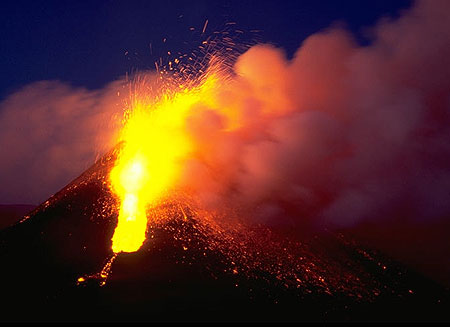Eruption from Etna volcano
|

What is a volcano?
word "volcano" comes from the Roman God of Fire, Vulcanus.
Also the small volcanic island of Vulcano in the Eolian Islands off
Sicily, was called after that god. Apparently, this island was highly active in
Ancient times and people believed its crater was the chimney of the Vulcanus'
forge, where the hot lava and ash coming out from the
crater were the visible evidence of his activity to forge weapons for
the other gods.
On Hawai'i, the people attributed volcanic activity to the beautiful,
but capricious and at times destructive goddess Pele, who loved fire and hated
water.
Today, a volcano is the term for any place on the surface of the earth,
where hot molten rock or magma is erupted or has been in the past.
 The most active volcanoes in the world
The most active volcanoes in the world
Kilauea volcano on Hawaii is the world's most active volcano, followed by
Etna in Italy and Piton de la Fournaise on La Réunion island.
After that, it is difficult to decide the exact order on the list,
but the following are very close: Stromboli, Merapi, Erta Ale, Ol Doinyo
Lengai, Unzen, Yasur, Ambrym, Arenal, Pacaya, Klyuchevsky, Sheveluch, and
Erebus.
What is the difference between an active,
erupting, dormant and extinct volcano?
An active volcano is a volcano that has had at least one eruption
during the past 10,000 years. An active volcano might be erupting or dormant.
An erupting volcano is an active volcano that is having an
eruption...
A dormant volcano is an active volcano that is not erupting, but
supposed to erupt again.
An extinct volcano has not had an eruption for at least 10,000
years and is not expected to erupt again in a comparable time scale of the
future
How do you know when a volcano cannot erupt
anymore?
When there are no signs of an active magma
chamber beneath the volcano (no unusual seismic activity, no volcanic gasses
escaping etc.), and when there hasn't been any activity for a long time span
(at least 10,000 years).
How would you find out if a volcano was
going to explode?
The answer to this complex topic is the
heart of the science of volcanology and its ultimate challenge.
While there is no easy and short answer,
this is the essence: you combine knowledge of the volcano's specific past
behaviour with all available observation of its present state, and this allows
you to make a long-term and a short term prediction:
1) You study the volcano's eruptive
behaviour in the past and ideally, you also try to find out
wether there were any signs of change before its eruptions. Such
changes might be: unusual seismic activity (i.e. earthquakes at the volcano),
visible or otherwise detectable deformation of the ground (i.e. opening of
cracks, swelling of the whole mountain etc.), changes in composition and
temperature of fumarolic gases and so on.
2) Then you monitor the volcano's
behaviour in the present, looking for such changes.
Based on the knowledge of the volcano's past,
you can make a long-term prediction (example: sooner or later, Mount Rainier is
going to erupt again, although nobody knows exactly when, but chances are
almost certain high that this might happen within the next few centuries).
The short-term prediction is possible when there are signs of change, and the
more is known about the volcano and the more data are available about its
present state, the more precise such predictions.
How dangerous are volcanoes?
Volcanoes are usually less dangerous than
other natural hazards such as earthquakes, tsunamis and hurricanes.
But there is no good answer if you don't
limit it into a specific context: which volcano? dangerous to what - people,
property, etc.? during which type of activity? at which location?
Volcanoes have a serious of hazards (e.g.
lava flows, ash fall, pyroclastic flows, climate changes on a global scale)
that relate into different dangers or risks. The risks when visiting an
active volcano depend on which risk zones of the volcano are visited and for
how long.
No comments:
Post a Comment